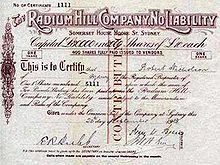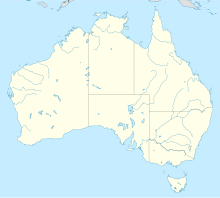Radium Hill
 Radium Hill minesite c.1954 | |
| Location | |
|---|---|
| Location | 460 km North East of Adelaide and 110 km South West of Broken Hill |
| State | South Australia |
| Country | Australia |
| Coordinates | 32°20′45.97″S 140°38′11.64″E / 32.3461028°S 140.6365667°E |
| Production | |
| Products | Davidite, Carnotite, Uranium |
| History | |
| Opened | 1906 |
| Closed | 1961 |
| Owner | |
| Company | abandoned |
| Year of acquisition | first pegged 1906 |
Radium Hill is a former minesite in South Australia which operated from 1906 until 1961.[1] It was Australia's first uranium mine,[2] years before the country's next major mines at Rum Jungle in the Northern Territory (opened in 1950), and the Mary Kathleen mine in Queensland (1958).[3] The associated settlement which once housed up to 1,100 people is now a ghost town, largely abandoned and demolished. The former townsite and cemetery were provisionally listed on the South Australian Heritage Register on 24 August 2016.[4] During its main period of production between 1954 and 1961 the mine produced nearly 1 million tonnes of davidite-bearing ore[5] to produce about 860 tons of U3O8.
History
[edit]The site was first pegged for mining in 1906 after prospector Arthur John Smith inadvertently discovered a radioactive material at a location approximately 40 kilometres (25 mi) East South East of Olary. Smith mistook the dark coloured ore he found for tin oxide or wolfram (tungsten).[6] His samples were sent to the University of Adelaide where young Sydney geologist and future Antarctic explorer, Douglas Mawson found the ore to contain radium and uranium. It also had traces of ilmenite, rutile, magnetite, hematite, pyrite, chalcopyrite intergrown with quartz and biotite, chromium, vanadium, and molybdenum.
Mawson named the uranium-bearing mineral davidite after geologist and Antarctic explorer, Sir Edgeworth David. The mine was initially called "Smith's Carnotite Mine" (a similar uranium-bearing mineral) and in September 1906 Mawson proposed the name "Radium Hill".[7] Smith worked the mine for the next two years before allowing the lease to lapse. Adjoining leases stretched for 5 kilometres (3.1 mi) along the lode, with one being half-owned by Mawson.

The Radium Hill Company took over the lease in 1908 and more shafts were sunk.
Ore concentrate was transferred to refineries in New South Wales and Victoria.[2] Radium had reached a price of £13,000 per gram in 1911,[8][A 1] and in the same year, at a cost of £15,000 the company built a refinery at Hunters Hill in New South Wales to produce radium compounds.[2] 350 milligrams of radium bromide (RaBr2) and 150 kg of uranium were produced.[1] The radium bromide was used for research in the emerging fields of radiation and radioactivity and some of the Hunters Hill radium was sold to pioneering nuclear researchers Ernest Rutherford and Marie Curie.[8]
Mining ceased in 1914 and the Hunters Hill refinery closed the following year.
The mine's second phase of operations started in 1923 when it was operated by the Radium and Rare Earth Treatment Company N.L. which continued operations there until 1931. The company also built a treatment plant in 1923 at Dry Creek near Adelaide to produce radium bromide for medical applications from the Radium Hill ore, however this proved to be uneconomic and both sites had ceased operations by 1932.[2]
Activity recommenced after World War II, with a Department of Mines geological survey in 1944 and exploration and drilling work done in 1946–1947. In March 1952 the Commonwealth and the South Australian governments signed a cost plus uranium supply contract with the UK-USA Combined Development Agency, initially for defence purposes, for delivery over seven years.[3] A section of Maldorkey Station was annexed and proclaimed a "Uranium mining reserve" in 1954[6] and the mine was officially opened by the Governor General of Australia, Field Marshal Sir William Slim on 10 November the same year.
The state government operated the mine and installed various infrastructure to support the operations. An 18 kilometres (11 mi) spur line connecting the site to the main Broken Hill railway line at Cutana Siding was built in 1954.[1] An aerodrome was constructed and roads improved in the same period. The town to house mine workers and their families was built also. This included 145 houses: in 1961 a population of 867 was recorded. Other town facilities included a hospital, school, government retail store, canteens, swimming pool, a bus service to Broken Hill and recreation and commercial facilities.
The main shaft of the mine was 420 metres (1,380 ft) deep with a 40 metres (130 ft) headframe.[1] Ore was crushed at a ball mill and treated on site at a surface concentrate mill using a heavy media separation and flotation process.[2] It was then rail-freighted to the purpose-built Port Pirie Uranium Treatment Complex which processed ore from Radium Hill and Myponga (Wild Dog Hill), south of Adelaide. The Port Pirie complex was also operated by the state government.[9][10]
The mine output was 970,000 tonnes of 0.09-0.13% ore and the ore concentrate produced a mix of about 150,000 tonnes of yellowcake which was then processed at Port Pirie where it was subjected to hot acid leaching, producing about 860 tons of U3O8 worth more than £15 million. After seven years of operations, the contract was filled and the plant officially decommissioned on 21 December 1961.[1][3]
Site rehabilitation
[edit]Restoration works on the site were undertaken in 1962 and again in 1981 when the tailings impoundment was covered with about 75,000 m³ of material from four adjacent borrow pits. Backfilling of old mine openings was also undertaken.[11]
Radioactive waste repository
[edit]From 1981 an area of the site was gazetted as a low-level radioactive waste repository.[12] Approximately 16 separate consignments of waste, including contaminated soil from Thebarton in the Adelaide metropolitan area was deposited there. The last deposit was made in 1998.
A New South Wales government study in 1979 found the incidence of cancer-related deaths by former Radium Hill workers to be four times the national average. According to the report, 59% of underground miners who had worked there for a period of two years or more had died of cancer.[1][2]
The site has been inactive since 1998. The Resources Division of Minerals and Energy at the Department of Primary Industry and Resources maintains management responsibility including a radiological watch on the site.
Quotes
[edit]" That one ounce of it is equal to one hundred thousand nominal horsepower, and that small quantity would be sufficient to drive or propel three of the largest battle ships afloat for a period of two thousand years; ...It will mean that foreign nations will be obliged to seek from us the power wherewith to heat and light their cities, and find means of defence and offence.."
See also
[edit]- ((Uranium mine south Australia))
- ((Ghost town|Ghost Town))
- ((Australia first uranium mine
Notes
[edit]- ^ Radium was discovered in 1898 by Marie Curie and she extracted the first pure metallic form of the element in 1908.
References
[edit]- ^ a b c d e f "Welcome". Radium Hill Historical Association. Archived from the original on 12 June 2009. Retrieved 27 July 2009.
- ^ a b c d e f "Radium Hill, SA". sea-us.org.au. Archived from the original on 13 September 2009. Retrieved 27 July 2009.
- ^ a b c "Australia's Uranium and Nuclear Power Prospects". World Nuclear Association. April 2009. Archived from the original on 2 November 2019. Retrieved 24 July 2009.
- ^ "Radium Hill Townsite and Cemetery" (PDF). South Australian Heritage Register. Department of Environment, Water and Natural Resources. Retrieved 28 December 2016.
- ^ "Radium Hill/Bonython Hill". Toro Energy Ltd. Archived from the original on 20 July 2008. Retrieved 27 July 2009.
- ^ a b Kevin R. Kakoschke (10 August 2005). ""A Clouded History" Radium Hill Australia's First Uranium Mine" (PDF). History Trust of South Australia. Archived from the original (PDF) on 24 October 2009. Retrieved 27 July 2009.
- ^ Transactions of the Royal Society of South Australia, V.30 1906
- ^ a b General Purpose Standing Committee No. 5. Chair: Ian Cohen (MLC) (September 2008). "The former uranium smelter site at Hunter's Hill" (PDF). Parliament of New South Wales. p. 16. Retrieved 28 July 2009.
{{cite web}}: CS1 maint: numeric names: authors list (link) - ^ "Uranium deposits in Australia". Government of South Australia Primary Industries and Resources. 13 March 2009. Retrieved 26 July 2009.
- ^ "Port Pirie Uranium Treatment Complex, SA". sea-us.org.au. Archived from the original on 8 May 1999. Retrieved 26 July 2009.
- ^ "Radium Hill Mine". South Australia Department of Primary Industry and Resources. Retrieved 27 July 2009.
- ^ Mcleary, M. (2004). "Radium Hill Uranium Mine and Low level Radioactive Waste Repository Management Plan Phase 1 - Preliminary Investigation 2004" (PDF). South Australia Department of Primary Industry and Resources. Archived from the original (PDF) on 4 August 2008.
- ^ "SOUTH AUSTRALIAN RADIUM". The Advertiser. Adelaide, SA: National Library of Australia. 13 May 1913. p. 15. Retrieved 26 February 2015.
Further reading
[edit]- Mudd, G M, 'The Legacy of Early Uranium Efforts in Australia 1906 to 1945: From Radium Hill to the Atomic Bomb and Today.' Historical Records of Australian Science, 2005, 16 (2) doi:10.1071/HR05013
- Mining in South Australia, 1982, Compiled by J. F. Drexel, Dept. of Mines & Energy South Australia, Special Publication No. 3.
- Mudd, G M, Compilation of Uranium Production History and Uranium Deposit Data Across Australia
External links
[edit]- Radium Hill Historical Association Retrieved 10 November 2022.

